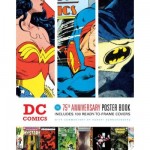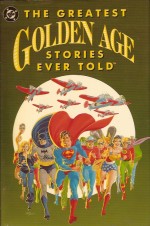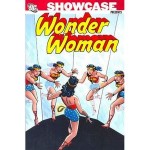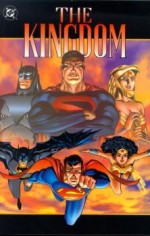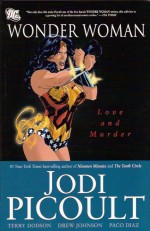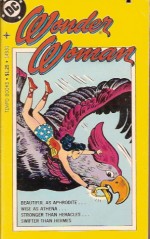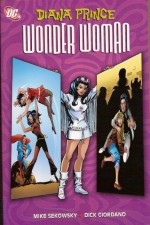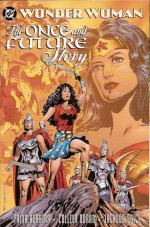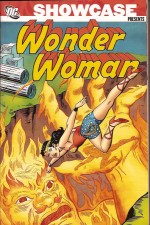
By Robert Kanigher, Ross Andru & Mike Esposito (DC Comics)
ISBN: 978-1-84856-474-9
Wonder Woman was created by psychologist and polygraph pioneer William Moulton Marston – apparently at the behest of his formidable wife Elizabeth – and uniquely realised by Harry G. Peter just as the spectre of World War II began to affect America.
She debuted as a bonus in All Star Comics #8 (December 1941) before vaulting into her own cover-featured series in Sensation Comics a month later. An instant hit, she quickly won her own title (cover-dated Summer 1942).
Using the pen-name Charles Moulton, Marston scripted all her adventures until his death in 1947, whereupon Robert Kanigher took over the writer’s role. Venerable co-creator H. G. Peter continued on as illustrator until his death in 1958. Wonder Woman #97, in April of that year, was his last hurrah and the end of an era.
With the exception of Superman, Batman, Wonder Woman and a few anodyne back-up features, costumed heroes had all but died out at the end of the 1940s, replaced by merely mortal champions in a deluge of anthologised genre titles but Showcase #4 rekindled the public’s interest in costumed crime-busters with a new iteration of The Flash in 1956 and the fanciful floodgates opened wide once more…
Whilst re-inventing Golden Age Greats such as Green Lantern, Atom and Hawkman, National/DC gradually updated those hoary survivors who had weathered the backlash and the ever-resilient Amazing Amazon …
Artists Ross Andru & Mike Esposito, who illustrated every script in this all-ages compendium, had debuted as cover artists from #95, but with Wonder Woman #98 (May 1958) they took over the interiors as writer/editor Kanigher reinvented much of the original mythos, tinkering with her origins and unleashing her on an unsuspecting world in a fanciful blend of girlish whimsy, rampant sexism, strange romance, alien invasion, monster-mashing and utterly surreal (some would say-stream-of-consciousness) storytelling…
By the time of this collection, re-presenting issues #138-156 (May 1963-August 1965) of the Amazing Amazon’s adventures, the Silver Age revival of the superhero genre was in full swing and despite individual stories of stunning imagination and excellence the format and timbre of Wonder Woman was looking tired and increasingly out of step with the rest of National/DC’s gradually gelling shared continuity.
While all the other champions and defenders were getting together and teaming up at the drop of a hat – as indeed was the Princess of Power in Justice League of America – within the pages of her own title a timeless, isolated fantasy universe was carrying on much as it always had.
Increasingly however, the Amazon was being sidelined by imaginary stories starring her younger selves Wonder Tot and Wonder Girl and even her mother Hippolyta was regularly stealing the show and the limelight.
With this volume though, the tide finally began to turn back in Diana’s favour…
‘The Kite of Doom! (#138) presented another spectacular “Impossible Day†adventure starring the entire Wonder Woman Family (that would be Princess Diana at three different ages acting in concert with her mother in tales which where outside even the amorphous and negligible continuity of the series, where internal consistency and logic were always notional and extremely mutable) and found the four faces of Wonder Woman again battling nuclear nemesis Multiple Man, alien invaders and the daily blazing fireball of doom…
‘The Day Wonder Woman Revealed her Secret Identity!’ saw the goddess Aphrodite inflict the Amazon with amnesia whilst meddling in her stalled romance with pilot Steve Trevor whilst WW #140 was another Impossible Tale with Wonder Woman transformed into ‘The Human Lightning!’ as Morpheus, god of dreams tested the entire Wonder Family before ‘The Academy of Arch-Villains!’ offered a reward for the destruction of the heroine and had to face the sinister machinations of Angle Man, the Human Fireworks and the diminutive but deadly Mouse Man.
The whole family were imperilled by terrifying trans-dimensional duplicates in ‘Captives of the Mirage Giants!’ another implausible Impossible Tale whilst issue #143 offered two tales, beginning with an alien invasion which could only be foiled by a mystic sword hidden within ‘The Terror Trees of Forbidden Island’, after which Wonder Woman was reduced to helplessness by the malignant Mouse Man and locked in ‘The Amazon Mouse Trap!’
Another brace of yarns featured in #144: the impressively clever ‘Revolt of Wonder Woman!’ wherein the tireless crusader suffered a stress-related breakdown until a blind girl restored her faith and determination and ‘Mer-Boy vs. Bird-Boy!’ with Wingo, an avian rival for Wonder Girl’s affections ,complicating an already busy day as the Teen Titan tackled invading aliens, enemy atomic submarines and the ever-deadly fireball from space…
The Wonder Woman Family were impossibly back to confront bad dreams and time-plunderers in ‘The Phantom Sea-Beast!’ but only Wonder Woman and Diana Prince were on hand to fight the ‘War of the Underwater Giants!’ and win thousands of dollars – for charity, of course – from a story-obsessed millionaire…
WW #147 featured an impossible tale from the Amazon’s teenage years as ‘Bird-Girl – Fish-Girl!’ her sea and sky boyfriends were given their heart’s desire by Athena and Aphrodite and both wished for a more physically compatible inamorata, whilst ‘The Olympics of the Doomed’ celebrated the 1964 Games with a stirring action romp in which the dread Duke of Deception captured Wonder Woman and compelled her to compete in a sudden-death competition on Mars…
In ‘The Last Day of the Amazons!’ the impossible Wonder Family almost triggered the destruction of Paradise Island when Queen Hippolyta’s passion for her long-lost lover causes his statue to come to life in a land where the presence of all males is severely proscribed by the goddesses…
Wonder Woman #150 offered ‘The Phantom Fisher-Bird!’ – a strange but thrilling yarn wherein the Wonder Family were hunted by giant man-birds from another plane of existence and ‘Wonder Girl vs. the Teenage Monster!’ (#151, January 1965) saw the Daring Damsel dogged and desired by a cosmic Glop which absorbed and mimicked anything: machinery, atomic weapons, Rock ‘n Roll records, juvenile delinquency…
With #152 the lass even took cover billing becoming Wonder Woman Presents Wonder Girl and featured another Impossible Tale with the young heroine resisting dinosaurs, mythological demons, invaders from Mars, disastrous weather and the importunate advances of Mer-boy and Bird-Boy in ‘Wonder Girl’s Decision of Doom!’ and found herself adopted by a deranged and traumatised trapeze artist who just knew that he was ‘Wonder Girl’s Mysterious Father!’
A far darker delusion haunted her in #153 as the Duke of Deception engineered ‘Wonder Girl’s Stolen Face!’ and turned her into an uncontrollable beast until Wonder Tot, Hippolyta and Wonder Woman found a face-saving solution…
‘Battle of the Boiling Man!’ in #154 saw the title revert to the mature iteration of the Female Fury in the penultimate Impossible Tale wherein wilful deities, mythical beasts and an ambulatory volcano all conspired to test the Amazons to destruction…
‘I Married a Monster!’ was a take on Beauty and the Beast wherein Wonder Woman, fed up with the constant badgering, bickering and marriage proposals of Steve Trevor, Manno and Wingo, swore off men for good and promptly fell in love with a brooding bad-boy brute trapped in a floating castle…
Just when it seemed the series could sink no lower Wonder Woman #156 changed everything with ‘The Brain Pirate of the Inner World!’ – a stylish adventure written and drawn in an effective and charming pastiche of Moulton & Peter’s glorious Golden Age Amazon.
When Wonder Woman visited the comics emporium of the Dream Merchant she was totally immersed and drawn into one of her past cases: “re-experiencing†a battle with other-dimensional buccaneers who had stolen the mentalities and enslaved the bodies of Steve and her old sidekicks the Holliday Girls…
Wild, bold, action-packed and thrilling, with all that mushy multi-species romance stuff dropped and her younger selves forgotten, a new kind of Wonder Woman was coming…
But not in this eclectic, eccentric collection which ends on this welcome high note.
Always delightful yet often mind-boggling and practically incomprehensible by modern narrative standards, these exuberant, effulgent fantasies are usually illogical and occasionally just plain bonkers, but in those days adventure in the moment was paramount and if you could put rationality and consistency aside for a moment these utterly infectious romps simply sparkled then and now with fun, thrills and sheer spectacle.
Wonder Woman is rightly revered as a focus of female strength, independence and empowerment, but the welcoming nostalgia and easy familiarity of such innocuous imaginative fairytales must be a magical escape for open-minded readers, whilst the true, incomparable value of these stories is the incredible quality entertainment they still offer.
© 1963, 1964, 1965, 2009 DC Comics, Inc. All Rights Reserved.
